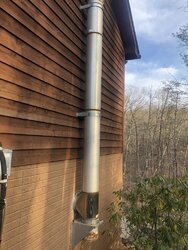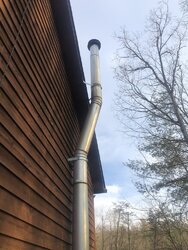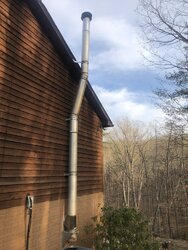Since smoke particles sticking to the flue walls are what form creosote, during the coaling stage you can go below the critical 250* flue temperature. Exterior chimneys cool much more than Interior, or “through the roof” straight up chimneys. So you have to allow more heat out of the stove for them. The increase in size of the connector elbow to 8 inch is a sign you probably have a 8 inch chimney outside, but you would need to remove the clean out cap if there is one outside to measure the flue size if you don’t know what it is. Pipe inside normally stays 6 inch for a 6 inch chimney.I did have the home inspected by a home inspector who also inspected the stove and set up. The previous owners gave me all the paperwork of installation which was done by a professional, the house was built 10 years ago and the woodstove was put in right after. They used it every winter, had it cleaned every winter and never had any issues. I’m not saying it ran as efficiently as it could, but no problems none the less. I can send some pictures of the outside of the house. I believe it’s all triple insulated pipe outside. Im used to a woodstove to heat up the huntin shack, not my house. I cleaned it before the winter and have been using it. If I run it for day or two my house heats easily into the mid 70’s. I didn’t realize how much there was to consider. Can you tell me a little bit more about “when it’s smoking” and a good running temp for it. It is possible he modified the system after the install. I appreciate your time, I’m sure your asked these questions constantly
When the flue is hot enough, water vapor from combustion is expelled from the top harmlessly. When allowed to cool, or not burning hard enough to generate the heat necessary to stay above condensing point, the smoke particles stick to the wet flue walls. So I use the term “when smoke is present”.
Since it is a guess how much cooling you have at the top of chimney, you can only burn hot and check creosote formation frequently. To get a good idea of the temperature needed at the bottom, an IR thermometer can be used on the inside of flue wall about a foot down to get a temperature reading and compare to the temperature of pipe wall at bottom so you know how much cooling you have in your particular system. An IR thermometer will also show you the drastic temperature difference from the 6 inch coming out of stove to the 8 inch pipe connecting to chimney. You just have to run with the air open more than you would with the correct size chimney, extending burn time and radiating more heat into the building than letting it up the stack.




